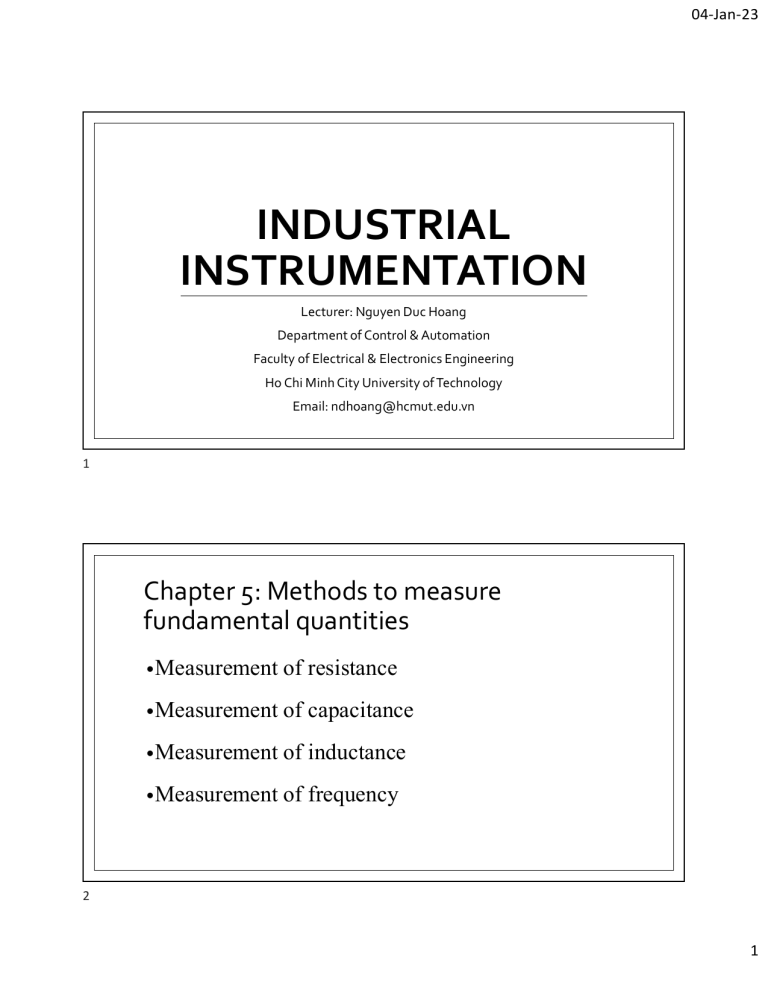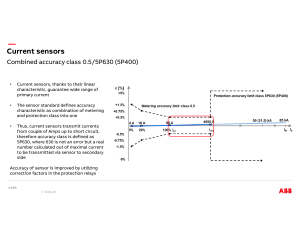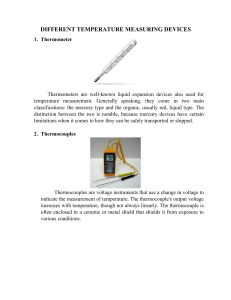Resistance Measurement Methods: Instrumentation Presentation
advertisement

04-Jan-23 INDUSTRIAL INSTRUMENTATION Lecturer: Nguyen Duc Hoang Department of Control & Automation Faculty of Electrical & Electronics Engineering Ho Chi Minh City University of Technology Email: ndhoang@hcmut.edu.vn 1 Chapter 5: Methods to measure fundamental quantities • Measurement of resistance • Measurement of capacitance • Measurement of inductance • Measurement of frequency 2 1 04-Jan-23 Measurement of resistance • Sensors based on the variation of the electric resistance of a device are very common: • POTENTIOMETERS • STRAIN GAGES • THERMISTORS, RTD • MAGNETORESISTORS • LIGHT-DEPENDENT RESISTORS • RESISTIVE HYGROMETERS • RESISTIVE GAS SENSORS • LIQUID CONDUCTIVITY SENSORS 3 Measurement of resistance • The general equation for a sensor whose resistance changes by a fraction x in response to a measurand is : 𝑅=𝑅 𝑓 𝑥 Assuming : 𝑓 0 = 1 • For linear sensors we have: 𝑅 =𝑅 1+𝑥 • The range of values for x depends strongly on the type of sensor and on the measurand span 4 2 04-Jan-23 Measurement of resistance • There are two requirements for all conditioners for resistive sensors: • they must drive the sensor with an electric voltage or current in order to obtain an output signal, • this supply, whose magnitude affects that of the output signal, is limited by sensor self-heating, 5 Measurement of resistance • Some sensors require particular circuits. Thermistors require linearization. • Strain gages require interference cancellation. • Sensors that yield small outputs require large gains in order for the dynamic range of the output signal to match the input range of the ADC . • Conditioners for remote sensors must be insensitive to connecting lead resistance or compensate for it. • 6 3 04-Jan-23 Measurement of resistance remote sensors 7 8 4 04-Jan-23 Measurement of resistance • Methods for resistance measurement can be classified into: • Deflection methods sense the drop in voltage across the resistance to be measured or the current through it or both. • Null methods are based on measurement bridges. 9 Measurement of resistance • Deflection method (1) 𝑉 = 𝑉 𝑅 1+𝑥 𝑅 10 5 04-Jan-23 Measurement of resistance • Deflection method (2) 𝑅=𝑅 𝑉 𝑉 11 Measurement of resistance • Voltage dividers : • commonly used to measure high-value resistances. 12 6 04-Jan-23 Measurement of resistance Example: The MGS1100 CO gas sensor (Motorola) has 1000 kΩ in air, from 30 k Ω to 300 k Ω (150 k Ω typical) for CO concentration of 60ppm (R60) , and a ratio R60/R400 = 2,5 (typical). If the allowable voltage across the sensing resistor and power dissipation in it are 5 V and 1mW, design a voltage divider for such a sensor if the expected CO concentration range is from 0 to 400ppm. 13 14 7 04-Jan-23 Measurement of resistance • Wheatstone bridge: balance measurements 15 Measurement of resistance • Wheatstone bridge: deflection measurements 16 8 04-Jan-23 Problems • A given Pt100 has R = 100 and = 6 mW/K when immersed in air and = 100 mW/K when immersed in still water. Calculate the maximal current through the sensor to keep the self-heating error below 0.10C. 17 A bridge circuit has R1 = R2 = R3 = R4 = 120Ohm resistances and a 10.0-V supply. Suppose a 3-1/2 digit DVM on a 200-mV scale will be used for the null detector. Find the resistance resolution for measurements of R4. 18 9 04-Jan-23 19 20 10 04-Jan-23 BT5 21 11




